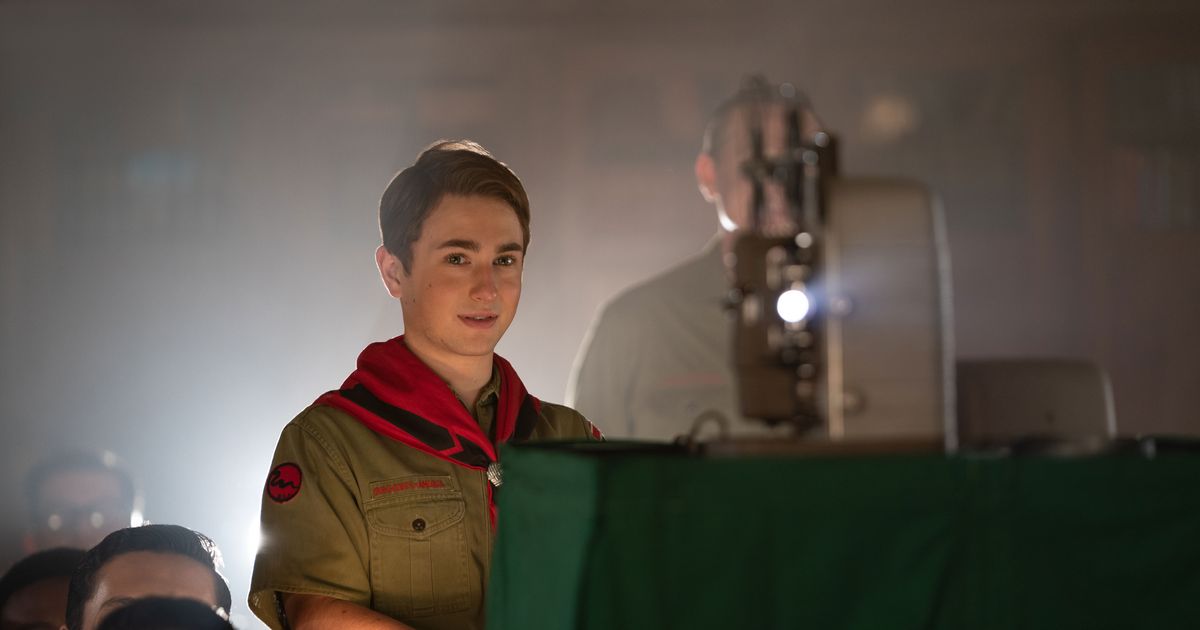
The Fabelmans’ Brilliant David Lynch Cameo Is All About Perspective
Steven Spielberg knew how The Fabelmans would end decades ago. The director’s semi-autobiographical film follows the journey of Sammy Fabelman (Gabriel LaBelle), a young, passionate filmmaker fated for greatness, eventually leading him to the office of another great filmmaker, John Ford. Sammy learns a lesson from his idol, the same wisdom Spielberg internalized over 50 years ago in his own meeting with Ford. At the end of a film that blurs the line between reality and movie mythmaking, a touching scene puts three legendary directors in one room thanks to a hilarious cameo.
The Fabelmans begins with Sammy’s family living in a close-knit Jewish enclave in New Jersey. His father Burt (an aching Paul Dano) works enthusiastically as a computer engineer, while his pianist mother Mitzi (Michelle Williams, transfixing) toils as an ebullient homemaker caught between maternal obligations and a desire for personal freedom. Burt’s best friend and co-worker Bennie (Seth Rogen) hangs around the family as a jokester and quasi uncle to Sammy.
Sammy gains an early appreciation for filmmaking when his parents take him to see Cecil B. DeMille’s The Greatest Show on Earth. The outing highlights the differences between his parents: While the practical and tech-savvy Burt explains how the human eye forms one fluid picture from 24 fast-moving stills, Mitzi, an artist at heart, explains that “movies are like dreams that you’ll never forget.” The film’s climactic train crash scares and excites a young Sammy so much that his mother Mitzi gives her son a camera to re-create the wreckage with his toy train set. The camera becomes the lens through which Sammy sees the world and his way of processing the best and worst memories of his childhood. With time, it also becomes the only avenue for him to understand his parents.
The Fabelmans, co-written by Spielberg and Tony Kushner, follows the beats of the director’s actual life: Burt moves his wife and children from their Jewish neighborhood to Phoenix, Arizona, for the promise of a new job. Burt, at Mitzi’s behest, even swings a gig for their friend Bennie, who accompanies them out west. Does Burt know how close Mitzi and Bennie are?
Sammy is mostly oblivious, partially because he’s too busy making homemade westerns with his friends to notice. Bennie and Mitzi’s affair becomes impossible to miss, though, as Sammy splices and rewinds footage from a recent family camping trip. The truth, revealed in an immaculate circle pan, nearly shatters the young filmmaker. (LaBelle is devastating in this scene where the character and director’s real-life pain blend together.)
Film can often demand uncommon honesty or coat facts and people in a gauzy mythology. It’s telling how, in an earlier scene, Sammy and his friends go see Ford’s The Man Who Shot Liberty Valance, a film about a local senator recounting how his rise to power was fueled by a lie about him shooting the titular famed outlaw. When given the chance to print the truth, the newspaper editor in the film, Maxwell (Carleton Young), instead prints the legend. In The Fabelmans, Sammy makes similar choices: He reedits the damning footage into a loving memory for his parents to enjoy.
The Fabelmans comprehends how movies can reshape reality, making it kinder and softer than our waking moments. The art of filmmaking is dependent on science and creativity, a union that in some ways parallels Burt and Mitzi’s, with Sammy as their conduit. Burt frays those circuits when he moves the family to a small town in Northern California, leaving Mitzi to pine for Bennie. Sammy, meanwhile, struggles to dodge the antisemitic bullies at his new school. One in particular, a jock named Logan (Sam Rechner), nearly breaks Sammy’s nose. But when given the chance to embarrass Logan while filming senior ditch day at the beach, Sammy once again prints the legend, rendering Logan as a kind of golden god. The footage shakes Logan, who can’t comprehend how the film made him “something he’s not” — perfect.
Sammy, initially, can’t understand it either. But Logan’s frightened reaction tells him that he can not only create different worlds through moviemaking but also alter others’ perceptions of our own universe and of themselves. Spielberg, of course, seems to have taken the lesson to heart. The Fabelmans is a sharply intended modification of his childhood, one in which blowout fights between his parents rarely occur, where forgiveness and empathy come easy, where the sets carry a dreamlike sheen, and where he is already a master filmmaker. It’s all an artfully calibrated hagiography where greatness was always assured because the camera made it so.
Through making The Fabelmans, Spielberg creates a controllable environment in which he can confront the uncomfortable: his parent’s porce. The director has drawn from his parents’ separation in several previous films. E.T. the Extra-Terrestrial, Close Encounters of the Third Kind, Catch Me If You Can, and even Lincoln all feature sons stuck between dysfunctional parents. Close Encounters of the Third Kind even features a musical mother and an electrically minded father who cannot communicate. In that film, humans are ultimately able to talk with visiting aliens through music played with computers (an observation perceptively made by James Lipton when Spielberg appeared on Inside the Actors Studio).
The father in Close Encounters chooses to leave Earth with the extraterrestrials, an ending Spielberg has admitted he reassessed after becoming a father himself; he no longer believes a loving father would unblinkingly leave his children. By the end of The Fabelmans, Burt and Mitzi have split, and the latter takes Sammy’s sisters with her. But Sammy and Burt remain together. They occupy a modest and bare Los Angeles apartment while Sammy searches for an entry point into Hollywood.
The budding director doesn’t find much luck in Tinseltown at first: Every letter he sends to a studio goes unanswered until, finally, an envelope arrives from the creator of Hogan’s Heroes. Sammy impresses the television producer enough for him to guide the young filmmaker to another office belonging to the “greatest director ever.”
The secretary tells Sammy it’ll be a while before the director returns. A gorgeous circle pan — one of many in this film — takes in a waiting area adorned with posters for John Ford’s most famous films: Stagecoach, The Searchers, and The Man Who Shot Liberty Valance, among others.
If you read about David Lynch agreeing to appear in The Fabelmans back in February, then you probably spent the movie anticipating his appearance. And he doesn’t disappoint. Ford, played by Lynch, barges through the door, his face covered in lipsticked kisses. Sporting an eye patch and a cigar and dressed like a big-game hunter, he defiantly limps through the frame. Lynch, a brilliant filmmaker in his own right, plays the craggy auteur as loud and brash. In an interview with the Film Stage, Kushner explained that it was his husband, Vulture contributing writer Mark Harris, who suggested Lynch should play Ford. Kushner shared the idea with Spielberg, who then asked Laura Dern to contact Lynch about possibly appearing as Ford. It’s pitch-perfect casting that only deepens the film’s layers between reality and fiction, character and persona.
In the scene, a nervous Sammy slinks toward Ford’s desk in a room whose walls are adorned with paintings of cowboys, cavalrymen, and Native Americans amid vast western landscapes. Ford lights a match from a boot-shaped striker and puffs on his cigar for so long he creates a cloud of smoke between himself and Sammy. Lynch’s deliberately awkward stillness only builds the anticipation. You’re just waiting for something outrageous to spring from his lips.
He points Sammy to a painting and asks him to describe it. Sammy stammers as he explains the scene of two men on horseback. But Ford doesn’t want to talk about who’s in the frame. He demands that Sammy point out where the horizon is in the painting, and then where it is in the next painting, then the next. The perspective in each of them is either in the extreme lower or upper third of the frame. Lynch plays up Ford’s bluster and swagger and creates a gruff, gravely voice to convey the imposing picture-maker’s stature. “Now remember this!” he bellows. “If the horizon’s at the bottom, it’s interesting. If the horizon’s at the top, it’s interesting. If the horizon’s in the middle, it’s boring as shit. Now, good luck to you. And get the fuck out of my office.”
The scene, based on Spielberg’s real-life meeting with the auteur at 15, perfectly ties the film’s binary interests together. It’s about perspective: Sammy, and in turn, Spielberg, come to see this story from two extremes — through the eyes of his mother and father — making these memories more complex, more fascinating. You can sense through The Fabelmans that Spielberg has spent these many decades considering both points of view, which may be why the film feels charged with clarity rather than spite. Sammy’s meeting with Ford is one of Spielberg’s most affecting, tender scenes, one in which a boy discovers where he belongs. After the camera does a classic Hollywood slick pan to Sammy skipping down the lot and past the soundstages, the lens winkingly reframes, breaking the perfect artificiality of Sammy’s story and reflecting Ford’s advice. A director, Spielberg, is born.










































![iFi's GO Bar Kensei Dongle DAC Supports K2HD Technology With Some Samurai Swagger [Updated] iFi's GO Bar Kensei Dongle DAC Supports K2HD Technology With Some Samurai Swagger [Updated]](https://i0.wp.com/cdn.ecoustics.com/db0/wblob/17BA35E873D594/33FF/45A11/QTXOLJR4xDKSNMMk2WlTgjaIlvSgcYpeU1xJzUwIoYs/ifi-go-bar-kensei.jpg?w=768&ssl=1)































